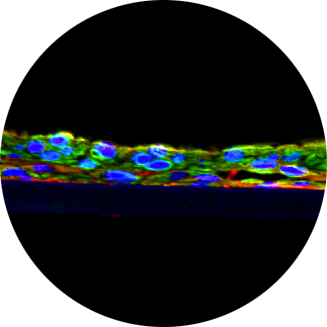A Novel Meso-Scale MPS Integrated Organ Platform to Evaluate Usnic Acid Kinetics, Organ Distribution and Cytotoxicity: A Case Study
- TR Number: 1038
- Authors: J.M. McKim, D. Austin, R. Sprando, S. Hermansky, W. Mattes, S. Fitzpatrick
- Materials Tested: Acetaminophen, Diclofenac, Usnic acid
Background and Purpose: Usnic acid (UA) is a secondary metabolite obtained from lichens from the genus Usnea. UA has been
reported to have a broad range of therapeutic uses that includes anti-inflammatory, antibacterial, and antiviral properties. In addition, UA is used in perfumes and cosmetics. Along with the reported beneficial effects, oral consumption of UA has also been associated with allergic reactions and with severe liver toxicity. It is therefore important to have new alternative methods that can be used to measure bioavailability, distribution, and organ-specific toxicity, metabolites, and kinetics in an in vitro system that is relevant to humans. This novel approach is needed to meet the demands of next generation risk assessment (NGRA). The primary aim of this study was to evaluate a new meso-scale microphysiology system that integrates multiple organs via a simulated blood flow system.
Methods: This in vitro MPS platform consisted of a three-compartment circuit (intestine, liver, and kidney). The human 3D
EpiIntestinalTM tissue was obtained from Mattek Corp.; the primary human hepatocytes from LifeNet Health were used for the liver; and the kidney was modeled with a normal human renal proximal tubule cell line (HK-2). Each organ compartment was isolated, and there was no fluid exchange between organ compartments. This allowed each organ model to be cultured under its own optimal conditions. Communication between organs was through a simulated blood flow system that incorporates a semipermeable membrane inside each organ compartment. This allows the test chemicals to move by osmotic diffusion into and out of the blood flow and organ compartments. Salts and other growth medium components are osmotically balanced. Flow was accomplished with a precision micro syringe pump (5 µL/min) and the simulated blood consisted of buffered saline (pH 7.4) with human serum albumin (0.1-0.4%). UA was applied to the apical surface of the intestine chamber (2, 20, and 60 µg). Samples (50 µL) were collected from each compartment at 0 hr, 5 min, 15 min, 30 min, 60 min, 1.5 hr, 2 hr, 4 hr, 8 hr, 24 hr, 48 hr, and 72 hr. These samples were analyzed by LC/MS/MS for UA, and kinetic concentration versus time curves were developed for each compartment. Following the 72-hour collection, the tissues were harvested and used to measure cytotoxicity.
Results: Intestinal exposure to UA reduced a marker of mitochondrial function (MTT) by 60-80% in a concentration dependent
manner; however, cell death measured by lactate dehydrogenase leakage (LDH) was only 15-20%. In the liver, ATP levels were
significantly reduced in a concentration dependent manner. Reduced glutathione (GSH) was completely depleted at all
concentrations. LDH leakage was observed with cell death estimated at 20%. In the kidney, a similar cytotoxic profile was observed.
Conclusions: These data indicate that UA targets the mitochondria and produces oxidative stress in cells, with the most significant
effects in liver. These findings are consistent with in vivo data reported by other laboratories. By combining kinetic data, physical
chemical properties, and cytotoxicity data, it will be possible to develop PBPK models for predicting exposure and identifying hazard
for NGRA

